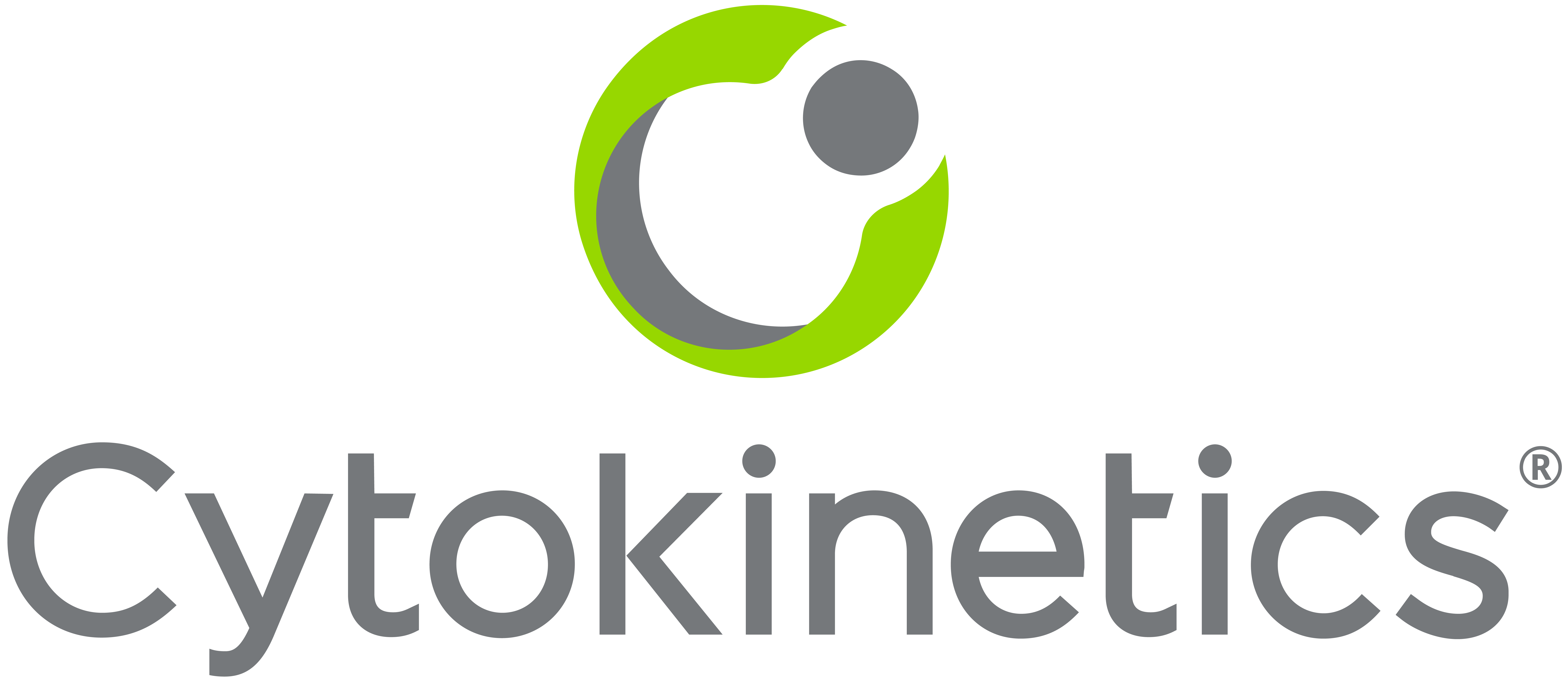Cytokinetics Announces Outcome of FDA Advisory Committee Vote On Omecamtiv Mecarbil
PDUFA Target Action Date is February 28, 2023
“We are disappointed there was not a greater consensus amongst Committee members relating to the benefit-risk of omecamtiv mecarbil, and we maintain our conviction in the strength of evidence supporting its potential benefit for patients suffering from HFrEF,” said
Omecamtiv mecarbil is an investigational, selective, small molecule cardiac myosin activator. If approved by the FDA, omecamtiv mecarbil will become the first therapy indicated for HFrEF that directly targets the mechanisms of the heart responsible for contraction – or its pumping function.
About GALACTIC-HF
The Advisory Committee’s recommendation was based on the results from GALACTIC-HF (Global Approach to Lowering Adverse Cardiac Outcomes Through Improving Contractility in Heart Failure), a Phase 3 clinical trial that enrolled 8,256 patients with HFrEF who were at risk of hospitalization and death, despite being well treated on standard-of-care therapy. The trial demonstrated a statistically significant effect of treatment with omecamtiv mecarbil to reduce risk of the primary composite endpoint of cardiovascular death or heart failure events compared to placebo in patients treated with standard of care (hazard ratio, 0.92; 95% confidence interval [CI] 0.86, 0.99; p=0.025).1 Results from the trial showed that the treatment effect of omecamtiv mecarbil was greater in the pre-specified subgroup of patients with lower left ventricular ejection fraction, a sign of worsening heart failure (LVEF ≤28%, n=4,456, hazard ratio, 0.84; 95% CI 0.77, 0.92; interaction p=0.003). This greater treatment effect was consistently observed in patients with other characteristics that may indicate worsening heart failure, such as being hospitalized within the last three months (HR 0.83, 95% CI 0.74 – 0.93, p=0.001), having New York Association Class III or IV heart failure (HR 0.80, 95% CI 0.71 – 0.90, p<0.001), higher N-terminal-pro brain natriuretic peptide levels (HR 0.77, 95% CI 0.69 – 0.87, p<0.001), and lower blood pressures (HR 0.81, 95% CI 0.70 – 0.92, p=0.002).
Approximately 2 million people in the
The New Drug Application (NDA) for omecamtiv mecarbil is currently under review by the FDA, with a Prescription Drug User Fee Act (PDUFA) target action date of
Conference Call and Webcast
About Omecamtiv Mecarbil
Omecamtiv mecarbil is an investigational, selective, small molecule cardiac myosin activator, the first of a novel class of myotropes3 designed to directly target the contractile mechanisms of the heart, binding to and recruiting more cardiac myosin heads to interact with actin during systole. Omecamtiv mecarbil is designed to increase the number of active actin-myosin cross bridges during each cardiac cycle and consequently augment the impaired contractility that is associated with heart failure with reduced ejection fraction (HFrEF). Preclinical research has shown that omecamtiv mecarbil increases cardiac contractility without increasing intracellular myocyte calcium concentrations or myocardial oxygen consumption.4-6
The development program for omecamtiv mecarbil assessed its potential for the treatment of HFrEF. Positive results from GALACTIC-HF, the first Phase 3 clinical trial of omecamtiv mecarbil demonstrated a statistically significant effect of treatment with omecamtiv mecarbil to reduce risk of the primary composite endpoint of cardiovascular (CV) death or heart failure events (heart failure hospitalization and other urgent treatment for heart failure) compared to placebo in patients treated with standard of care. No reduction in the secondary endpoint of time to CV death was observed. Adverse events and treatment discontinuation of study drug were balanced between treatment arms.
About Heart Failure
Heart failure is a grievous condition that affects more than 64 million people worldwide7 about half of whom have reduced left ventricular function.8,9 It is the leading cause of hospitalization and readmission in people age 65 and older.10,11 Despite broad use of standard treatments and advances in care, the prognosis for patients with heart failure is poor.12 An estimated one in five people over the age of 40 are at risk of developing heart failure, and approximately 50% of people diagnosed with heart failure will die within five years of initial hospitalization.13,14 Approximately 2 million people in the
About
For additional information about Cytokinetics, visit www.cytokinetics.com and follow us on Twitter, LinkedIn, Facebook and YouTube.
Forward-Looking Statements
This press release contains forward-looking statements for purposes of the Private Securities Litigation Reform Act of 1995 (the "Act").
CYTOKINETICS® and the
Contact:
Senior Vice President, Corporate Communications, Investor Relations
(415) 290-7757
References:
- Teerlink J et al. NEJM. 2020.
Shannon M. Dunlay ,Véronique L. Roger ,Susan A. Weston , Ruoxiang Jiang, andMargaret M. Redfield (Circ Heart Fail. 2012;5:720-726.); Olmsted County community cohort of HF patients (1984 to 2009).- Psotka MA, Gottlieb SS, Francis GS et al. Cardiac Calcitropes, Myotropes, and Mitotropes. JACC. 2019; 73:2345-53.
- Planelles-Herrero VJ, Hartman JJ, Robert-Paganin J. et al. Mechanistic and structural basis for activation of cardiac myosin force production by omecamtiv mecarbil.
Nat Commun . 2017;8:190. - Shen YT, Malik FI, Zhao X, et al. Improvement of cardiac function by a cardiac myosin activator in conscious dogs with systolic heart failure. Circ Heart Fail. 2010; 3: 522-27.
- Malik FI, Hartman JJ, Elias KA, Morgan BP, Rodriguez H, Brejc K, Anderson RL, Sueoka SH, Lee KH, Finer JT, Sakowicz R. Cardiac myosin activation: a potential therapeutic approach for systolic heart failure. Science. 2011 Mar 18;331(6023):1439-43.
- James et al. GBD 2017 Disease and Injury Incidence and Prevalence Collaborators.
Lancet 2018; 392: 1789–858. - Yancy CW, Jessup M, Bozkurt B, et al. 2013 ACCF/AHA Guideline for the Management of Heart failure: A Report of the American College of Cardiology Foundation/American Heart Association Task Force on Practice Guidelines. Circulation. 2013;128:e240-e327.
- Ponikowski P, Voors AA, Anker SD, et al. 2016 ESC guidelines for the diagnosis and treatment of acute and chronic heart failure: The Task Force for the diagnosis and treatment of acute and chronic heart failure of the European Society of Cardiology (ESC). Developed with the special contribution of the Heart Failure Association (HFA) of the ESC. Eur Heart J. 2016;37:2129–2200.
- Roger VL. Epidemiology of Heart Failure.
Circulation Research . 2013;113:646-659, originally published August 29, 2013. Doi: 10.1161/CIRCRESAHA.113.300268. - Kilgore M, Patel HK, Kielhorn A et al. Economic burden of hospitalizations of Medicare beneficiaries with heart failure. Risk Manag Healthc Policy. 2017; 10: 63-70.
- Jhund PS, MacIntyre K, Simpson CR, et al. Long-Term Trends in First Hospitalization for Heart Failure and Subsequent Survival Between 1986 and 2003. Circulation. 2009;119:515-523.
- Benjamin EJ, Virani SS, Callaway CW et al. Heart Disease and Stroke Statistics—2018 Update: A Report From the American Heart Association. Circulation. 2018;137:e67-e492.
- Roger VL, Weston SA, Redfield MM, et al. Trends in Heart Failure Incidence and Survival in a Community-Based Population. JAMA. 2004;292:344-350.
Source: Cytokinetics, Incorporated



